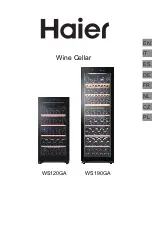
Page 20 | 1-855-235-5271
TWS
092115
INSTALLING THE CONDENSING UNIT
Connect the 4 valve manifold gauge set to the liquid line king valve and suction line service valve ports on the Condensing
Unit.
Suction Line Service Valve, and Liquid Line King Valve Instructions
The condensing unit is shipped from the factory with both valve stems front seated. This means the valve stem has been
rotated clockwise all the way in. (With the valve stem in this position the refrigerant line is closed, and the service port is
open.) There is a plastic cap installed over the service port from the factory. The valves are sent in this orientation to keep the
factory nitrogen charge inside of the condensing unit. The factory nitrogen charge is used solely to prevent moisture and
contaminants from entering the system prior to the install.
The valve stem will need to be mid-seated to evacuate and charge the system. Follow the instructions below for valve stem
seating instructions.
Back seat both valves by rotating the valve stem counter clockwise until the stem stops. (Do not over torque the valve stem
as this will cause the packing between the valve stem and valve body to leak.) Once the valve stem is fully back seated
rotate the valve stem one and a half turns clockwise. This will keep the refrigerant line all the way open and allow the service
valves to be open for evacuation and charging purposes.
Evacuation
Close off the high and low side valves on the manifold gauge set. Connect the charging hose from the manifold gauge set
to the outlet of the charging scale. Connect another refrigerant hose to a tank of R404a and to the inlet of the charging
scale. Open the tank of R404a and place it on a charging scale in the upside down position, with the power turned off to the
condensing unit. Set the charging scale to 60 grams. Press the charge button and loosen the charging hose from the
manifold gauge. This process is very important as it will purge out any air that is trapped between the refrigerant tank,
charging scale, and manifold gauge set. Once the liquid refrigerant begins to flow out of the hose, tighten the charging
hose to the manifold gauge set.
Energize the liquid line solenoid valve (Meaning make sure the evaporator units are wired together, turned on, and calling
for cooling). Connect a micron gauge directly to the pump, blank off, and start the pump to verify that it is capable of a
200 micron vacuum and the gauge is capable of reading that vacuum. Connect a micron gauge in line with the vacuum
hose at the manifold gauge set. Remove the Schrader Valve Depressors from the gauge hoses to reduce restriction and
connect gauges to the suction and liquid line service valve service ports on the Condensing Unit. Connect the pump to the
vacuum hose on the manifold gauge set. Start the pump and run until the micron gauge reads 200 microns.
When a 200 micron level evacuation is achieved, close off the pump and turn it off. Let the system sit for two minutes,
monitoring the vacuum level. Ensure the system vacuum level does not rise above 500 microns, this will confirm that all
moisture has been removed from the system as well ensure there are no leaks. If the vacuum level does rise above 500
microns, perform a leak check, repair leaks if necessary, and repeat the evacuation process.
Charging
Close off the high and low side valves on the manifold gauge set. Remove the vacuum pump and the micron gauge from
the system. Open the refrigerant valve on the manifold gauge set and charge the system with 3.5lbs of R404a. Set the
refrigerant tank in the upright position. Turn power on to the condensing unit and allow the system to run for 10 minutes.
Observe the sight glass for bubbles. If bubbles are present open the low side valve on the manifold gauge set and monitor
the sight glass. Once the bubbles begin to disappear close off the low side valve on the manifold gauge to stop the flow of
refrigerant. Allow the system to run for a period of 5 minutes. Observe the sight glass for bubbles, if bubbles are still present,
open the low side valve on the manifold gauge set and admit more vapor into the system. Once the sight glass is full and
stays full for a period of 10 minutes the system is fully charged.
Fill a wine bottle ¾ full with water between 60-75°F. Insert the bottle probe into the neck of the bottle as far as
possible. (It is important the bottle probe stopper is compressed by the neck of the bottle to ensure water will not leak
out). Verify that the bottle probe is properly installed and the set point on the controller is low enough to allow the
system to run continuously for 30 minutes or more.
















































